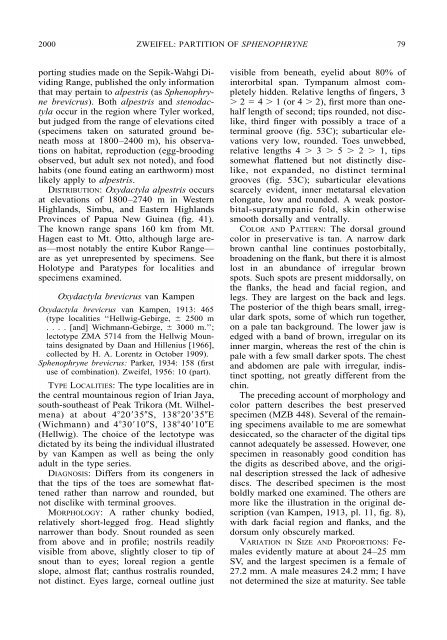SPHENOPHRYNE - American Museum of Natural History
SPHENOPHRYNE - American Museum of Natural History
SPHENOPHRYNE - American Museum of Natural History
You also want an ePaper? Increase the reach of your titles
YUMPU automatically turns print PDFs into web optimized ePapers that Google loves.
2000 ZWEIFEL: PARTITION OF <strong>SPHENOPHRYNE</strong><br />
79<br />
porting studies made on the Sepik-Wahgi Dividing<br />
Range, published the only information<br />
that may pertain to alpestris (as Sphenophryne<br />
brevicrus). Both alpestris and stenodactyla<br />
occur in the region where Tyler worked,<br />
but judged from the range <strong>of</strong> elevations cited<br />
(specimens taken on saturated ground beneath<br />
moss at 1800–2400 m), his observations<br />
on habitat, reproduction (egg-brooding<br />
observed, but adult sex not noted), and food<br />
habits (one found eating an earthworm) most<br />
likely apply to alpestris.<br />
DISTRIBUTION: Oxydactyla alpestris occurs<br />
at elevations <strong>of</strong> 1800–2740 m in Western<br />
Highlands, Simbu, and Eastern Highlands<br />
Provinces <strong>of</strong> Papua New Guinea (fig. 41).<br />
The known range spans 160 km from Mt.<br />
Hagen east to Mt. Otto, although large areas—most<br />
notably the entire Kubor Range—<br />
are as yet unrepresented by specimens. See<br />
Holotype and Paratypes for localities and<br />
specimens examined.<br />
Oxydactyla brevicrus van Kampen<br />
Oxydactyla brevicrus van Kampen, 1913: 465<br />
(type localities ‘‘Hellwig-Gebirge, 2500 m<br />
....[and] Wichmann-Gebirge, 3000 m.’’;<br />
lectotype ZMA 5714 from the Hellwig Mountains<br />
designated by Daan and Hillenius [1966],<br />
collected by H. A. Lorentz in October 1909).<br />
Sphenophryne brevicrus: Parker, 1934: 158 (first<br />
use <strong>of</strong> combination). Zweifel, 1956: 10 (part).<br />
TYPE LOCALITIES: The type localities are in<br />
the central mountainous region <strong>of</strong> Irian Jaya,<br />
south-southeast <strong>of</strong> Peak Trikora (Mt. Wilhelmena)<br />
at about 42035S, 1382035E<br />
(Wichmann) and 43010S, 1384010E<br />
(Hellwig). The choice <strong>of</strong> the lectotype was<br />
dictated by its being the individual illustrated<br />
by van Kampen as well as being the only<br />
adult in the type series.<br />
DIAGNOSIS: Differs from its congeners in<br />
that the tips <strong>of</strong> the toes are somewhat flattened<br />
rather than narrow and rounded, but<br />
not disclike with terminal grooves.<br />
MORPHOLOGY: A rather chunky bodied,<br />
relatively short-legged frog. Head slightly<br />
narrower than body. Snout rounded as seen<br />
from above and in pr<strong>of</strong>ile; nostrils readily<br />
visible from above, slightly closer to tip <strong>of</strong><br />
snout than to eyes; loreal region a gentle<br />
slope, almost flat; canthus rostralis rounded,<br />
not distinct. Eyes large, corneal outline just<br />
visible from beneath, eyelid about 80% <strong>of</strong><br />
interorbital span. Tympanum almost completely<br />
hidden. Relative lengths <strong>of</strong> fingers, 3<br />
2 4 1 (or 4 2), first more than onehalf<br />
length <strong>of</strong> second; tips rounded, not disclike,<br />
third finger with possibly a trace <strong>of</strong> a<br />
terminal groove (fig. 53C); subarticular elevations<br />
very low, rounded. Toes unwebbed,<br />
relative lengths 4 3 5 2 1, tips<br />
somewhat flattened but not distinctly disclike,<br />
not expanded, no distinct terminal<br />
grooves (fig. 53C); subarticular elevations<br />
scarcely evident, inner metatarsal elevation<br />
elongate, low and rounded. A weak postorbital-supratympanic<br />
fold, skin otherwise<br />
smooth dorsally and ventrally.<br />
COLOR AND PATTERN: The dorsal ground<br />
color in preservative is tan. A narrow dark<br />
brown canthal line continues postorbitally,<br />
broadening on the flank, but there it is almost<br />
lost in an abundance <strong>of</strong> irregular brown<br />
spots. Such spots are present middorsally, on<br />
the flanks, the head and facial region, and<br />
legs. They are largest on the back and legs.<br />
The posterior <strong>of</strong> the thigh bears small, irregular<br />
dark spots, some <strong>of</strong> which run together,<br />
on a pale tan background. The lower jaw is<br />
edged with a band <strong>of</strong> brown, irregular on its<br />
inner margin, whereas the rest <strong>of</strong> the chin is<br />
pale with a few small darker spots. The chest<br />
and abdomen are pale with irregular, indistinct<br />
spotting, not greatly different from the<br />
chin.<br />
The preceding account <strong>of</strong> morphology and<br />
color pattern describes the best preserved<br />
specimen (MZB 448). Several <strong>of</strong> the remaining<br />
specimens available to me are somewhat<br />
desiccated, so the character <strong>of</strong> the digital tips<br />
cannot adequately be assessed. However, one<br />
specimen in reasonably good condition has<br />
the digits as described above, and the original<br />
description stressed the lack <strong>of</strong> adhesive<br />
discs. The described specimen is the most<br />
boldly marked one examined. The others are<br />
more like the illustration in the original description<br />
(van Kampen, 1913, pl. 11, fig. 8),<br />
with dark facial region and flanks, and the<br />
dorsum only obscurely marked.<br />
VARIATION IN SIZE AND PROPORTIONS: Females<br />
evidently mature at about 24–25 mm<br />
SV, and the largest specimen is a female <strong>of</strong><br />
27.2 mm. A male measures 24.2 mm; I have<br />
not determined the size at maturity. See table
















